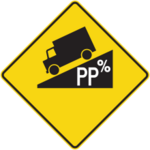Traffic signs
Warning signs
Warning signs inform road users where there is an obstacle, an actual (or potential) danger on or near a public highway. They warn users to be vigilant, slow down, or perform a manoeuvre such as changing lanes or stopping their vehicle.
The background of these signs is usually yellow. Here are a few examples.
The percentage indicates that the angle and length are equal to or greater than:
6% for at least 600 metres;
7% for at least 300 metres;
8% for at least 250 metres;
9% for at least 150 metres;
11% for at least 120 metres;
13% for at least 100 metres;
15% for at least 60 metres.
The higher the percentage, the steeper the grade. The pictogram shows a truck, as drivers of heavy vehicles must take special precautions. Motorists must also be vigilant, especially if the grade includes a bend or the road surface is slippery.
Prepare to Stop (traffic lights ahead)
The following sign indicates an intersection with traffic lights ahead.

The sign has amber beacons which start flashing when the traffic lights are going to turn red. This sign is used in particular on roads with speeds of 90 km/h and over when the distance to see the lights is insufficient to safely manoeuvre.
Prepare to Stop (railway crossing ahead)
This sign indicates the presence of a railway crossing ahead.

When the beacons on this sign are flashing, this means that the signals at the railway crossing are flashing. This sign is used in particular on roads with speeds of 90 km/h and over when the distance to see the lights is insufficient to safely manoeuvre.
Prepare to Stop (traffic congestion ahead)
This sign indicates that an area where traffic is congested is ahead.

It can be installed in areas with long queues, such as in approaches to boat crossings or freeway exits with cyclic backups. The beacons generally start flashing when traffic is moving at less than 20 km/h in an urban environment and at less than 40 km/h in a rural environment.
Prepare to Stop at an Oversized Truck Entrance
This sign indicates an entrance for oversized trucks ahead, where the stopping sight distances are insufficient.
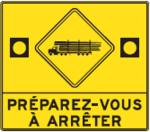
The yellow beacons flash when a truck enters a public highway to warn the driver of a possible obstruction.
School Bus Stop Ahead
This sign warns drivers that they may have to stop if a school bus is stopped to let schoolchildren get on or off the bus.
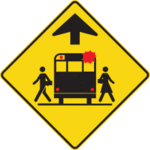
It is installed when the distance to see the bus stop or schoolchildren is insufficient and it is impossible to move the stop to a safer location.
Bicycle Crossing or Designated Roadway
The following sign indicates the presence of cyclists in three situations.
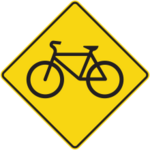
More specifically, it indicates the presence of a crossing for cyclists on a bikeway. It is also installed to indicate the presence of cyclists on a paved shoulder on a bicycle route. Finally, it indicates the presence of a designated roadway.
Visit Traffic Rules for Cyclists to find out about other types of signs for bicycles.
Several signs like this one are placed along the curve to mark its outer edge. These chevrons make the curve easier to see. They are generally installed when you need to reduce your speed by at least 35 km/h to make a safe turn. On freeways, they are installed when you need to reduce your speed by at least 5 km/h.
Hazard Marker
These signs indicate the presence of obstacles on the roadway or shoulders, as well as indicating where a public highway narrows.


The oblique lines on these signs are always oriented toward the side to be used to skirt the obstacle. The obstacle may be a rock or the low wall of a bridge, for example.
Lane Ends
This sign indicates that the number of lanes in the same direction is reduced. You will need to change lanes if you are in a lane that is about to end.

Roadway Narrows
The following signs indicate that there is a reduction in pavement width but not in the number of traffic lanes. You should therefore pay close attention to the change in configuration shown by these signs.

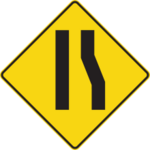
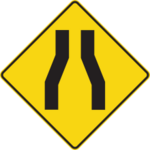
Directional Arrow
The following signs indicate the presence of a particularly dangerous spot in a sharp curve or in a T intersection. More pronounced curves are indicated either by markers or by chevron alignments.
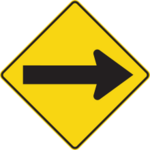

Restricted Visibility
The following sign indicates that sight distance is limited or even nonexistent in a vertical curve or grade. These signs are installed if the sight distance to an obstacle is less than the stopping distance of a vehicle.
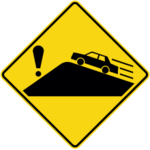
A sign with the pictogram of an agricultural vehicle can also be used when the danger is more related to the presence of this type of vehicle in a rural environment.

See also
Last update: October 10, 2023


